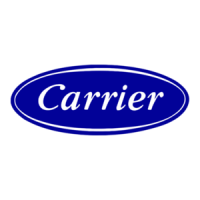INSTALLATION GUIDE
Up to four fan coil units can be connected to one outdoor unit.
Refer to the Product Data for approved combinations.
Ideal installation locations include:
Each Indoor Unit
• A location where there are no obstacles near inlet and outlet area.
• A location which can bear the weight of indoor unit.
• Do not install indoor units near a direct source of heat such as
direct sunlight or a heating appliance.
• A location which provides appropriate clearances as outlined in
Fig. 2.
Outdoor Unit
• A location which is convenient to installation and not exposed to
strong wind. If unit is exposed to strong winds it is
recommended that a wind bafi]e be used. Contact your Carrier
Representative for drawings. (See Fig. 10)
• A location which can bear the weight of outdoor unit and where
the outdoor unit can be mounted in a level position.
• A location which provides appropriate clearances as outlined in
Fig. 3.
• Do not install the indoor or outdoor units in a location with
special environmental conditions. For those applications, contact
your Carrier Representative.
INDOOR UNIT INSTALLATION
INSTALL MOUNTING PLATE
For each fan coil:
1. Carefully remove the mounting plate, which is attached to
the back of the indoor unit.
2. The mounting plate should be located horizontally and level
on the wall.
3. If the wall is block, brick, concrete or similar material, drill
.2" (5 mm) diameter holes and insert anchors for the ap-
propriate mounting screws.
4. Attach the mounting plate to the wall.
cp
Fig. 4 - 9k Mounting Plate Spacing
cp 95
A085862
21 93 (557)
5
Note: Units in ( ) = mm
Fig. 5 - 12k Mounting Plate Spacing
A08291
Fig. 6 - 18k Mounting Plate Spacing
A09655
FOR EACH FAN COIL, DRILL HOLE IN WALL
FOR INTERCONNECTING PIPING, DRAIN AND
WIRING
Refrigerant Line Routing
The refrigerant lines may be routed in any of the four directions
shown in Fig. 7 (a) and (b).
For maximum serviceability, it is recommended to have refrigerant
line flare connections and the drain connection on the outside of
the wall that the fan coil is mounted on.
As viewed from front
Knockout 3
@ Righ_ _ @ Left Exi t _ ic_Ou_ _
_2j_ Right Rear Exit "_@ Left Rear Exit
(a) (b) (c)
A08281
Fig. 7 - Refrigerant Line Routing
If piping is going through the back:
1. Determine pipe hole position using the mounting plate as a
template. Drill pipe hole diameter per chart below. The
outside pipe hole is l/2-in. (13 mm) min. lower than inside
pipe hole, so it slants slightly downward (see Fig. 8).
If piping is going to exit from the left rear, it is recommen-
ded to field-fabricate piping extensions to get the flare con-
nections to the outside of the wall.
1/2 in. (13 mm)
Min.
INDOOR OUTDOOR
Fig. 8 - Drill Holes
Hole Diameter
Unit Size
in. (ram)
9k, 12k, and 18k 3.75 (95)
A07371
If piping is going through the right or left side:
1. Use a small saw blade to carefully remove the correspond-
ing plastic covering on side panel and drill the appropriate
size hole where the pipe is going through the wall. See Fig.
7(c).
2. Remove knockout 1 if you are running only the wiring.
Remove knockout 1 and 2 or knockout 1, 2 and 3 if you are
running both piping and wiring through the side of the unit.

